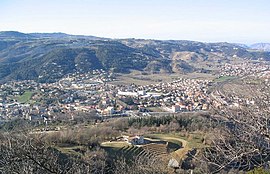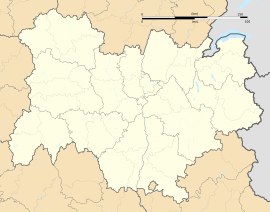Saint-Péray
You can help expand this article with text translated from the corresponding article in French. (December 2008) Click [show] for important translation instructions.
|
Saint-Péray | |
|---|---|
 A general view of Saint-Péray | |
| Coordinates: 44°56′58″N 4°50′45″E / 44.9494°N 4.8458°E | |
| Country | France |
| Region | Auvergne-Rhône-Alpes |
| Department | Ardèche |
| Arrondissement | Tournon-sur-Rhône |
| Canton | Guilherand-Granges |
| Government | |
| • Mayor (2020–2026) | Jacques Dubay[1] |
| Area 1 | 24.05 km2 (9.29 sq mi) |
| Population (2021)[2] | 7,588 |
| • Density | 320/km2 (820/sq mi) |
| Time zone | UTC+01:00 (CET) |
| • Summer (DST) | UTC+02:00 (CEST) |
| INSEE/Postal code | 07281 /07130 |
| Elevation | 107–652 m (351–2,139 ft) (avg. 128 m or 420 ft) |
| 1 French Land Register data, which excludes lakes, ponds, glaciers > 1 km2 (0.386 sq mi or 247 acres) and river estuaries. | |
Saint-Péray (French pronunciation: [sɛ̃ peʁɛ] ; Occitan: Sant Pèire d'Ai) is a commune in the Ardèche department in the Auvergne-Rhône-Alpes region in southern France. Historically part of the royal province of Vivarais, it has been a significant settlement since the 15th century when inhabitants moved from the fortified castle of Crussol to the valley of Mialan. The village was originally named Saint-Pierre d'Ay, which later evolved into its current name, Saint-Péray.
Geography
[edit]Saint-Péray is located at the foot of Crussol Hill, in the western part of the Valence urban area, bordering the Rhône Valley. It serves as a transit point between the Ardèche mountains and the plains of Valence. The commune is characterized by its geological features, primarily composed of sedimentary layers that support a diverse Mediterranean flora and fauna, despite its relatively high latitude.
Climate
[edit]The climate in Saint-Péray is classified as Mediterranean with variations, characterized by hot summers and cooler winters. The average annual temperature is around 12.9°C, with significant temperature fluctuations throughout the year. Rainfall is concentrated in the autumn months, with an annual average of approximately 933 mm.
Hydrography
[edit]The eastern part of the commune is bordered by the Rhône River, while the Mialan, a tributary of the Rhône, flows through the town.
Transport
[edit]Saint-Péray is accessible via several roadways, including the D86, which connects Lyon to Nîmes. The commune is also served by local bus lines and has a railway station that can accommodate passenger services on a temporary basis.
Demographics
[edit]As of 2021, Saint-Péray had a population of 7,588 inhabitants, reflecting a slight increase from previous years. The residents are known as Saint-Pérollais.
|
| ||||||||||||||||||||||||||||||||||||||||||||||||||||||||||||||||||||||||||||||||||||||||||||||||||||||||||||||||||
| Source: EHESS[3] and INSEE (1968-2020)[4] | |||||||||||||||||||||||||||||||||||||||||||||||||||||||||||||||||||||||||||||||||||||||||||||||||||||||||||||||||||
Economy
[edit]Saint-Péray is renowned for its wine production, particularly its white wines, which are often sparkling and classified within the Saint-Péray appellation, part of the Côtes du Rhône wine region. The local vineyards primarily cultivate the Roussanne and Marsanne grape varieties, producing wines with a pale yellow hue and floral aromas.
Cultural and Historical Significance
[edit]The commune has a rich historical background, with references to its early existence found in documents dating back to the 10th century. Saint-Péray has preserved its cultural heritage through various communal activities and partnerships with other European towns, including Groß-Umstadt in Germany and Santo Tirso in Portugal.
Education and Facilities
[edit]Saint-Péray hosts several educational institutions, including primary schools and a secondary school, the Collège de Crussol. The community also features sports facilities and a media library.
See also
[edit]- Château de Crussol, located on the territory of the commune.
- Communes of the Ardèche department
References
[edit]- ^ "Répertoire national des élus: les maires" (in French). data.gouv.fr, Plateforme ouverte des données publiques françaises. 13 September 2022.
- ^ "Populations légales 2021" (in French). The National Institute of Statistics and Economic Studies. 28 December 2023.
- ^ Des villages de Cassini aux communes d'aujourd'hui: Commune data sheet Saint-Péray, EHESS (in French).
- ^ Population en historique depuis 1968, INSEE



